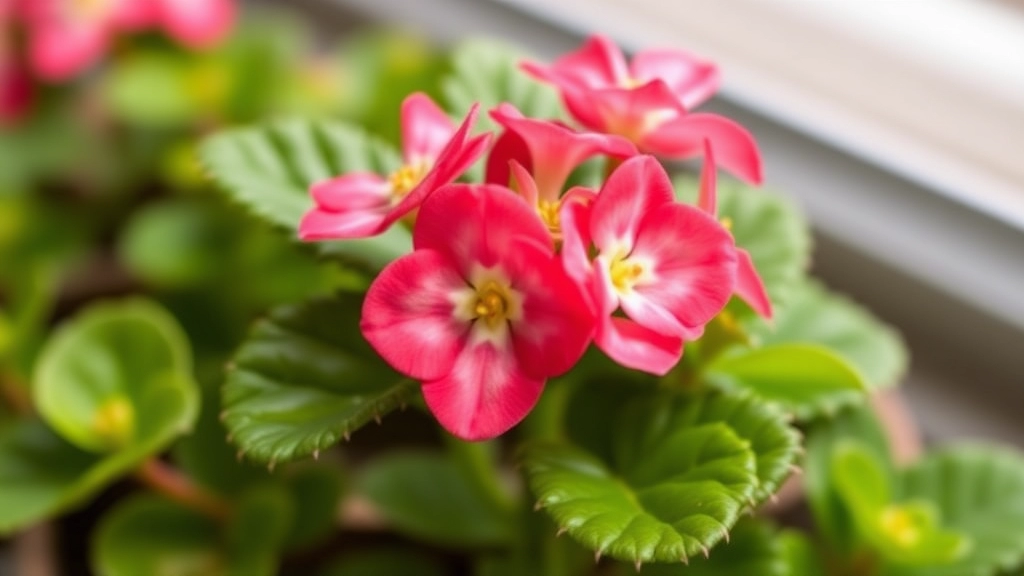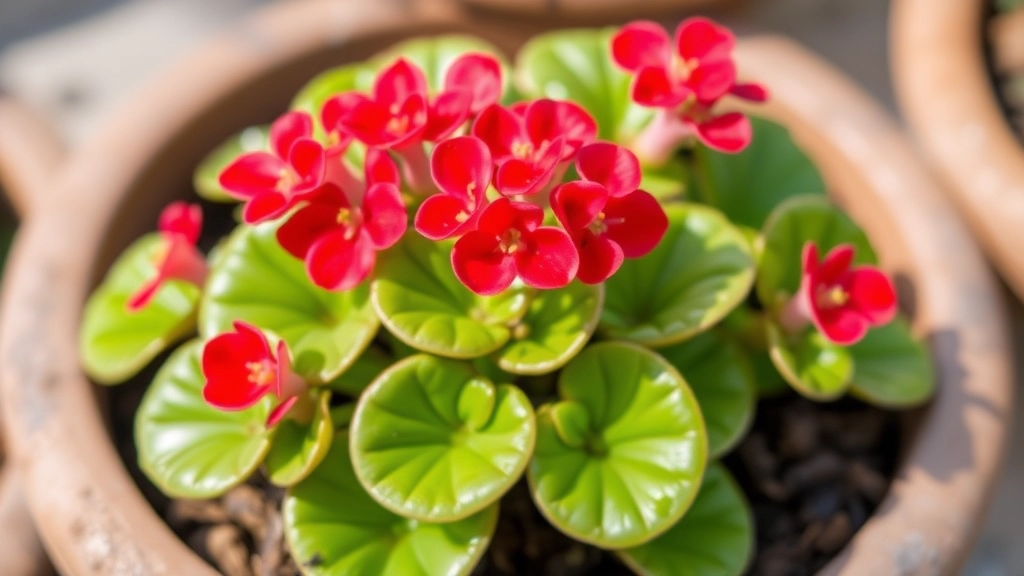The Round Leaf Kalanchoe
The Round Leaf Kalanchoe, a captivating succulent, is a favourite among plant enthusiasts for its unique appearance and easy care. Recognising this plant’s distinct round leaves and vibrant colours is the first step to appreciating its beauty. Whether you’re a novice or an experienced gardener, understanding the key characteristics of the Round Leaf Kalanchoe will help you identify it effortlessly.
Caring for Your Round Leaf Kalanchoe
Caring for your Round Leaf Kalanchoe involves a few essential steps to ensure it thrives, both indoors and outdoors. From selecting the right soil and fertiliser to mastering watering techniques and understanding its climate needs, this guide covers all the basics. Additionally, we’ll explore common challenges and provide practical solutions to keep your plant healthy and flourishing.
Identifying the Round Leaf Kalanchoe
Are you struggling to identify the Round Leaf Kalanchoe among the many succulent varieties?
This charming plant, known scientifically as Kalanchoe luciae, is often characterised by its thick, round leaves that resemble a paddle.
Key Features to Look For:
- Leaf Shape: The leaves are thick, fleshy, and oval-shaped, often with a vibrant green hue.
- Leaf Edges: They may have a subtle reddish tint along the edges, especially when exposed to bright light.
- Growth Habit: This succulent typically grows upright, forming a rosette pattern that adds visual interest to any indoor or outdoor setting.
- Flowers: When in bloom, the Round Leaf Kalanchoe produces clusters of small, tubular flowers in shades of orange or yellow, which can be quite striking.
Identifying this plant is the first step to ensuring it thrives in your care. For more detailed information, check out the care guide for Kalanchoe luciae. Additionally, you might find our Kalanchoe species identification guide helpful in distinguishing between different varieties.
Essential Care Tips for Growing Kalanchoe Indoors

So, you’ve decided to bring a Round Leaf Kalanchoe into your home—great choice! But now you might be wondering, how do I keep this beauty thriving indoors?
Light Requirements
First off, let’s chat about light.
Kalanchoes love bright, indirect sunlight.
- Ideal Spot: A south or west-facing window is perfect.
- Avoid Direct Sun: Too much direct sun can scorch those lovely leaves.
If your plant starts stretching towards the light, it’s a sign it’s not getting enough.
Watering Wisely
Next up, watering.
This is where a lot of folks go wrong.
- Check the Soil: Always stick your finger in the soil. If it’s dry an inch down, it’s time to water.
- Drainage is Key: Make sure your pot has drainage holes. Kalanchoes hate sitting in soggy soil.
Temperature and Humidity
Now, let’s talk about temperature and humidity.
Kalanchoes are pretty chill about their environment, but they do have preferences.
- Ideal Temperature: Keep it between 18-24°C (65-75°F).
- Humidity Levels: They prefer low humidity. So, if you live in a humid area, consider using a dehumidifier.
Fertilizing Your Plant
Fertilizing is another key aspect of care.
- Frequency: A balanced liquid fertilizer every month during the growing season is ideal.
- Dilution: Always dilute it to half-strength—Kalanchoes don’t like to be overfed.
Pruning and Grooming
Lastly, let’s not forget about grooming.
- Remove Dead Leaves: Regularly check for any dead or yellowing leaves and snip them off.
- Shape It Up: You can also pinch back the stems to encourage bushier growth.
By following these essential care tips, you’ll set your Round Leaf Kalanchoe up for success indoors.
Outdoor Growth Considerations and Climate Needs
When considering the outdoor growth of the Round Leaf Kalanchoe, it’s essential to understand its specific climate requirements. Many gardeners often wonder if their local climate is suitable for this unique succulent.
Common Challenges and How to Avoid Them

As we delve deeper into caring for the Round Leaf Kalanchoe, it’s essential to address some common challenges that can hinder its growth and vibrancy.
1. Overwatering
One of the most frequent issues is overwatering. Round Leaf Kalanchoe thrives in well-draining soil and prefers to dry out between waterings.
- Tip: Check the soil moisture before watering.
- Signs of Overwatering: Yellowing leaves and a mushy stem.
- Solution: Allow the soil to dry completely before the next watering session.
2. Insufficient Light
These plants adore bright, indirect sunlight. Too little light can lead to leggy growth and a lack of flowering.
- Tip: Place your Kalanchoe near a window with filtered light.
- Signs of Insufficient Light: Stretched stems and pale leaves.
- Solution: Move to a brighter location or supplement with grow lights.
3. Pest Infestations
Pests like mealybugs and aphids can be a nuisance. They can sap the plant’s energy and lead to further complications.
- Tip: Regularly inspect the leaves for any signs of pests.
- Solution: Use insecticidal soap or neem oil for treatment.
4. Temperature Fluctuations
Round Leaf Kalanchoe prefers stable temperatures. Extreme cold or heat can stress the plant.
- Tip: Keep it in a room with temperatures between 15-25°C.
- Signs of Temperature Stress: Dropping leaves or wilting.
- Solution: Avoid placing near drafts or heating vents.
5. Nutrient Deficiency
Lack of essential nutrients can stunt growth.
- Tip: Use a balanced, diluted fertiliser during the growing season.
- Signs of Deficiency: Slow growth and discoloured leaves.
- Solution: Fertilise every 4-6 weeks during spring and summer.
Propagation Methods for Round Leaf Kalanchoe
When it comes to expanding your collection of Round Leaf Kalanchoe, understanding the best propagation methods can make all the difference. Many plant enthusiasts often wonder how to successfully propagate their Kalanchoe to ensure healthy growth.
1. Leaf Cuttings
One of the simplest ways to propagate Round Leaf Kalanchoe is through leaf cuttings. Here’s how:
- Select a healthy leaf from the parent plant.
- Using a clean, sharp knife, cut the leaf at the base.
- Allow the cut end to dry for a few hours to form a callus.
- Place the leaf on well-draining soil, ensuring the cut end is in contact with the soil.
- Water sparingly until roots develop.
2. Offsets
Kalanchoe plants often produce offsets, or small plantlets, that can be separated for propagation.
- Gently remove the offset from the parent plant.
- Ensure it has some roots attached.
- Plant it in a pot with suitable soil and water lightly.
3. Stem Cuttings
Another effective method is using stem cuttings.
- Cut a healthy stem, ideally around 4-6 inches long.
- Remove the lower leaves to expose the nodes.
- Allow the cut end to dry for a day before planting it in soil.
- Keep the soil slightly moist until roots form.
4. Seed Propagation
For those interested in a more traditional approach, seeds can also be used, although this method is less common with Kalanchoe.
- Plant seeds in a seed tray filled with a light potting mix.
- Keep the soil moist but not soggy.
- Provide warmth and light to encourage germination.
Remember, patience is key in propagation. It may take a few weeks for roots to develop, but the reward of new plants is well worth the wait. For more detailed guidance, check out our step-by-step guide on propagating Kalanchoe from leaves and our complete guide on propagating Kalanchoe Chocolate Soldier.
Choosing the Best Soil and Fertilizer for Optimal Growth
So, you’ve got your Round Leaf Kalanchoe, and now you’re wondering about the best soil and fertilizer to keep it thriving, right?
Let’s dive into that.
Soil Selection
Choosing the right soil is crucial for your Kalanchoe. You want something that drains well but still retains some moisture. Here’s what I recommend:
- Cactus Mix: A pre-made cactus or succulent mix is a great option. It’s designed to provide the drainage these plants love.
- DIY Mix: If you’re feeling adventurous, mix regular potting soil with perlite or sand. Aim for a 2:1 ratioâtwo parts soil to one part drainage material.
- pH Level: Kalanchoe prefers slightly acidic to neutral soil (pH 6.0 to 7.0). You can test your soil with a simple pH kit if you’re curious.
Fertilizer Choices
Now, onto fertilizer. This can be a bit tricky, but don’t worry; I’ve got you covered.
- Type: Use a balanced, water-soluble fertilizer. Something like a 10-10-10 mix works wonders.
- Frequency: Feed your Kalanchoe every 4-6 weeks during the growing season (spring and summer). In autumn and winter, cut back; they don’t need as much love then.
- Dilution: Always dilute your fertilizer to half-strength. Too much can burn those lovely leaves.
Additional Tips
- Signs of Over-fertilization: If your leaves start to yellow or drop, you might be overdoing it. Scale back and flush the soil with water to help clear out any excess nutrients.
- Seasonal Adjustments: Remember, your Kalanchoe’s needs change with the seasons. Adjust your fertilization schedule accordingly.
By paying attention to soil and fertilizer, you’re setting your Round Leaf Kalanchoe up for a happy life. For more detailed care tips, check out this ultimate guide on Kalanchoe care and explore different Kalanchoe species for your garden.
FAQs on Caring for Round Leaf Kalanchoe
What kind of light does a Round Leaf Kalanchoe need?
Kalanchoes thrive in bright, indirect sunlight. An ideal spot would be near a south or west-facing window. Avoid placing them in direct sunlight, as it can scorch their leaves.
How often should I water my Round Leaf Kalanchoe?
Water your Kalanchoe when the soil is dry an inch down. Overwatering can be detrimental, so ensure the pot has drainage holes to prevent the plant from sitting in soggy soil.
What is the ideal temperature and humidity for a Round Leaf Kalanchoe?
Keep the temperature between 18-24°C (65-75°F) and maintain low humidity levels. If you live in a humid area, consider using a dehumidifier.
How often should I fertilize my Round Leaf Kalanchoe?
Fertilize your plant with a balanced liquid fertilizer every month during the growing season. Always dilute the fertilizer to half-strength to avoid overfeeding.
How do I prune and groom my Round Leaf Kalanchoe?
Regularly remove any dead or yellowing leaves. You can also pinch back the stems to encourage bushier growth.
What are common signs of overwatering?
Signs of overwatering include yellowing leaves and a mushy stem. Make sure to let the soil dry completely before watering again.
How can I tell if my Round Leaf Kalanchoe is not getting enough light?
If your plant has stretched stems and pale leaves, it’s likely not receiving enough light. Move it to a brighter location or use grow lights to supplement.
What should I do if my Kalanchoe has pests?
Regularly inspect the leaves for signs of pests like mealybugs and aphids. If you notice any, treat the plant with insecticidal soap or neem oil.
How can I avoid temperature stress for my Kalanchoe?
Maintain stable temperatures between 15-25°C and avoid placing your plant near drafts or heating vents. Signs of temperature stress include dropping leaves or wilting.
What are the signs of nutrient deficiency in a Round Leaf Kalanchoe?
Signs of nutrient deficiency include slow growth and discolored leaves. Fertilize every 4-6 weeks during the spring and summer to ensure your plant gets the nutrients it needs.
References
-
The Spruce: Growing Kalanchoe Succulents Indoors
-
Gardening Know How: Kalanchoe Plant Care
-
The Old Farmer’s Almanac: How to Grow and Care for Kalanchoe
